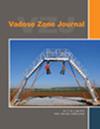对寒冷和干旱地区的 SMAP 土壤水分产品进行降尺度处理:将 NDSI 和 BSI 纳入随机森林算法
IF 2.8
3区 地球科学
Q3 ENVIRONMENTAL SCIENCES
引用次数: 0
摘要
土壤水分(SM)是水文循环、地表过程和地表能量平衡的关键要素。然而,常用土壤水分产品的空间分辨率较低,限制了土壤水分在寒冷干旱地区农业和生态水文学中的应用。本研究在传统降尺度因子(包括地表温度、归一化差异植被指数、数字高程模式、视热惯性、反照率和温度植被干燥指数)的基础上,增加了归一化差异土壤指数(NDSI)和裸土指数(BSI),因为它们与此类地区裸土-植被交替区的地表SM具有更强的相关性。利用随机森林算法,为该区域构建了 SM 的降尺度模型。通过与 2021 年 5 月至 9 月(土壤非冰冻期)收集的原始 SM 数据进行比较,验证了降尺度 SM 估计值的准确性。结果表明,新加入的 NDSI 和 BSI 与 SM 具有良好的相关性。在构建降尺度模型时加入 NDSI 和 BSI,其精度比不加入 NDSI 和 BSI 时提高了 19% 以上,同时还能更全面地反映土壤信息。NDSI和BSI可以很好地应用于裸露土壤-植被交替区SM的降尺度研究,对寒冷干旱地区的生态水文研究和农业干旱监测具有重要价值。本文章由计算机程序翻译,如有差异,请以英文原文为准。
Downscaling SMAP soil moisture product in cold and arid region: Incorporating NDSI and BSI into the random forest algorithm
Soil moisture (SM) is a critical element of the hydrological cycle, land surface processes, and surface energy balance. However, the low spatial resolution of commonly used SM products limits the application of SM in agriculture and eco‐hydrology in cold and arid regions. In this study, the normalized difference soil index (NDSI) and bare soil index (BSI) were added to traditional downscaling factors including land surface temperature, normalized difference vegetation index, digital elevation mode, apparent thermal inertia, Albedo, and temperature vegetation dryness index, as they are more strongly correlated with surface SM in the bare soil‐vegetation alternation zone of such region. Using the random forest algorithm, a downscaling model of SM was constructed for such region. The accuracy of the downscaled SM estimates was validated by comparing them with the original SM data collected from May to September 2021, which is the non‐freezing period of the soil. The findings indicate that the newly added NDSI and BSI have good correlation with SM. Incorporating NDSI and BSI to construct the downscaled model enhances the accuracy by over 19% compared to excluding them, while also providing a more comprehensive representation of SM information. NDSI and BSI can be well applied to the downscaled research of SM in the bare soil‐vegetation alternation zone, which is of great value for the study of eco‐hydrology and agricultural drought monitoring in cold and arid regions.
求助全文
通过发布文献求助,成功后即可免费获取论文全文。
去求助
来源期刊

Vadose Zone Journal
环境科学-环境科学
CiteScore
5.60
自引率
7.10%
发文量
61
审稿时长
3.8 months
期刊介绍:
Vadose Zone Journal is a unique publication outlet for interdisciplinary research and assessment of the vadose zone, the portion of the Critical Zone that comprises the Earth’s critical living surface down to groundwater. It is a peer-reviewed, international journal publishing reviews, original research, and special sections across a wide range of disciplines. Vadose Zone Journal reports fundamental and applied research from disciplinary and multidisciplinary investigations, including assessment and policy analyses, of the mostly unsaturated zone between the soil surface and the groundwater table. The goal is to disseminate information to facilitate science-based decision-making and sustainable management of the vadose zone. Examples of topic areas suitable for VZJ are variably saturated fluid flow, heat and solute transport in granular and fractured media, flow processes in the capillary fringe at or near the water table, water table management, regional and global climate change impacts on the vadose zone, carbon sequestration, design and performance of waste disposal facilities, long-term stewardship of contaminated sites in the vadose zone, biogeochemical transformation processes, microbial processes in shallow and deep formations, bioremediation, and the fate and transport of radionuclides, inorganic and organic chemicals, colloids, viruses, and microorganisms. Articles in VZJ also address yet-to-be-resolved issues, such as how to quantify heterogeneity of subsurface processes and properties, and how to couple physical, chemical, and biological processes across a range of spatial scales from the molecular to the global.
 求助内容:
求助内容: 应助结果提醒方式:
应助结果提醒方式:


